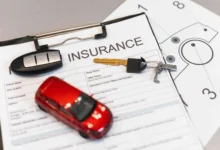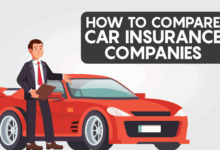Car Insurance Companies: A Comprehensive Guide
Car insurance companies play a vital role in our lives, offering crucial financial protection against the unexpected costs associated with vehicle accidents and damage. Understanding the diverse landscape of these companies—from large national providers to smaller regional insurers and direct writers—is essential for making informed decisions about your coverage. This guide explores the various types of car insurance companies, the factors that influence premiums, and the process of selecting the best policy for your individual needs.
Navigating the world of car insurance can be complex, with numerous factors influencing the cost and coverage options available. This exploration delves into the intricacies of policy details, including liability, collision, and comprehensive coverage, while also providing practical advice on navigating the claims process and finding the most suitable insurer. We will also examine how car insurance companies assess risk for high-risk drivers, and how that affects premiums and coverage.
Types of Car Insurance Companies
Choosing the right car insurance company can significantly impact your premiums and the level of coverage you receive. Understanding the different types of insurers available is crucial for making an informed decision. This section will explore the various categories of car insurance companies, highlighting their strengths and weaknesses.
Large National Companies
Large national car insurance companies, such as State Farm, Geico, and Progressive, offer widespread availability and extensive advertising. Their significant market share often translates to competitive pricing, especially for standard coverage. However, their size can sometimes lead to less personalized service and a more bureaucratic claims process. The sheer volume of claims they handle might result in longer wait times for resolutions. They often utilize sophisticated technology for quick quotes and online services, but this can also mean a less personal touch.
Regional Insurers
Regional insurers focus their operations on a specific geographic area. This allows them to better understand the local risks and tailor their policies accordingly. They may offer more competitive rates for drivers within their service area compared to national companies, as their understanding of local driving conditions allows for more accurate risk assessment. However, their limited geographical reach restricts their availability, and they might lack the resources and technological advancements of larger national competitors.
Direct Writers
Direct writers, such as Geico and Progressive, sell their insurance directly to consumers without the use of independent agents. This business model typically results in lower overhead costs, which can translate to lower premiums for customers. The streamlined process often offers quick quotes and online policy management. However, the lack of an intermediary can make it more difficult to address complex claims or receive personalized advice. Customers deal directly with the insurance company, which may not always be advantageous in case of disputes.
Independent Agents
Independent agents represent multiple insurance companies, allowing them to shop around for the best rates and coverage options on behalf of their clients. This personalized service can be particularly beneficial for individuals with complex insurance needs or those seeking specialized coverage. They provide expert guidance and advocacy in the event of a claim. However, the commission they earn from the insurance companies may influence their recommendations, and their services might come at a slightly higher cost than dealing directly with a direct writer.
Comparison of Car Insurance Company Types
| Company Type | Coverage Options | Typical Customer Profile | Advantages | Disadvantages |
|---|---|---|---|---|
| Large National Company (e.g., State Farm) | Comprehensive, collision, liability, uninsured/underinsured motorist | Broad range of drivers, seeking convenience and brand recognition | Wide availability, competitive pricing, extensive online resources | Potentially impersonal service, longer claims processing times |
| Regional Insurer (e.g., a smaller, state-based company) | Similar to national companies, but potentially with more specialized options for local risks | Drivers within the insurer’s service area, valuing local expertise | Potentially lower premiums for local drivers, personalized service | Limited geographic reach, may lack technological advancements |
| Direct Writer (e.g., Geico) | Standard coverage options, often with online customization | Tech-savvy drivers comfortable managing insurance online, seeking low premiums | Lower premiums due to lower overhead, quick online quotes and management | Limited personal interaction, potential difficulties with complex claims |
| Independent Agent | Wide range of options from multiple insurers | Drivers with complex needs, seeking personalized advice and advocacy | Personalized service, access to multiple insurers and competitive quotes | Potentially higher cost due to agent commissions, possible influence on insurer selection |
Factors Affecting Car Insurance Premiums
Your car insurance premium isn’t a random number; it’s calculated based on a variety of factors that assess your risk as a driver. Understanding these factors can help you make informed decisions and potentially lower your costs. Insurance companies use sophisticated algorithms to weigh these factors, resulting in a personalized premium.
Several key elements contribute significantly to determining your car insurance premium. These factors interact in complex ways, and a change in even one can substantially affect your final cost.
Driving Record
A clean driving record is crucial for securing lower premiums. Insurance companies view accidents and traffic violations as indicators of higher risk. Multiple accidents or serious offenses like DUI (Driving Under the Influence) will significantly increase your premiums. Conversely, a driver with no accidents or violations for several years will typically qualify for lower rates, often receiving discounts for safe driving. The severity and frequency of incidents heavily influence the premium calculation. For instance, a minor fender bender will have less impact than a major accident resulting in injuries or significant property damage.
Age
Age is a significant factor, reflecting statistical trends in driving experience and accident rates. Younger drivers, particularly those under 25, generally pay higher premiums due to their higher accident risk. As drivers gain experience and age, their premiums typically decrease, reaching their lowest point in middle age. This is because statistically, older drivers are less likely to be involved in accidents than younger drivers. However, premiums may increase again in very advanced age due to potential health issues affecting driving ability.
Location
Where you live impacts your insurance rates. Areas with higher crime rates, more traffic congestion, and a greater frequency of accidents generally have higher insurance premiums. Insurance companies analyze claims data for specific zip codes to assess risk levels. Living in a rural area with lower accident rates may result in lower premiums compared to living in a densely populated urban center.
Vehicle Type
The type of vehicle you drive significantly affects your insurance costs. Sports cars and high-performance vehicles are generally more expensive to insure due to their higher repair costs and greater potential for accidents. Conversely, smaller, less powerful vehicles are often associated with lower premiums. The vehicle’s safety features also play a role; cars with advanced safety technology may qualify for discounts. The cost of parts and repairs is a major factor here; a vehicle with readily available, inexpensive parts will be cheaper to insure than one requiring specialized or expensive components.
Credit Score
In many states, your credit score is a factor in determining your car insurance premium. While the correlation isn’t always clear, insurance companies use credit scores as an indicator of risk. Individuals with poor credit scores are sometimes viewed as higher risk, potentially leading to higher premiums. This practice is controversial, but it’s important to understand that your credit score can influence your insurance rates in certain jurisdictions. Improving your credit score can potentially lead to lower premiums in these cases.
Hypothetical Scenario
Imagine two drivers, both 30 years old with clean driving records. Driver A lives in a suburban area and drives a fuel-efficient sedan, while Driver B lives in a large city and drives a high-performance sports car. Even with similar ages and driving records, Driver B will likely pay significantly more for car insurance due to the higher risk associated with the vehicle type and location. If Driver A were to get a speeding ticket, their premium would increase, though likely not as drastically as if Driver B were to get into a major accident, which would substantially raise their premium due to the high repair costs of their sports car. This illustrates how these factors interact to determine the final cost.
Coverage Options and Policy Details
Choosing the right car insurance coverage is crucial for protecting yourself financially in the event of an accident or other unforeseen circumstances. Understanding the different types of coverage and their implications is key to making an informed decision. This section details the various options available and explains their benefits in practical scenarios.
Liability Coverage
Liability coverage protects you financially if you cause an accident that injures someone or damages their property. It covers the costs of medical bills, lost wages, and property repairs for the other party involved. This coverage is typically expressed as a three-number limit, such as 25/50/25, representing $25,000 per person injured, $50,000 total per accident for injuries, and $25,000 for property damage. For example, if you cause an accident resulting in $30,000 in medical bills for one person, your $25,000 liability coverage would only cover that amount, leaving you responsible for the remaining $5,000.
Collision Coverage
Collision coverage pays for repairs or replacement of your vehicle if it’s damaged in an accident, regardless of who is at fault. This means even if you cause the accident, your insurance will help cover the cost of fixing your car. Deductibles apply, meaning you’ll pay a certain amount out-of-pocket before your insurance kicks in. For instance, if you hit a tree and your car sustains $2,000 in damage with a $500 deductible, your insurance will pay $1,500.
Comprehensive Coverage
Comprehensive coverage protects your vehicle against damage caused by events other than collisions, such as theft, vandalism, fire, hail, or falling objects. Like collision coverage, it typically involves a deductible. Imagine a hailstorm causing $3,000 in damage to your car; with a $1,000 deductible, your insurance would cover $2,000 of the repairs.
Uninsured/Underinsured Motorist Coverage
Uninsured/underinsured motorist (UM/UIM) coverage protects you if you’re involved in an accident caused by an uninsured or underinsured driver. It covers your medical bills, lost wages, and vehicle repairs if the other driver’s insurance is insufficient or nonexistent. For example, if an uninsured driver causes an accident resulting in $10,000 in damages to your vehicle and $5,000 in medical bills, your UM/UIM coverage would help cover these costs, up to your policy limits.
Claims Process and Customer Service
Navigating a car insurance claim can be stressful, but understanding the process and knowing what to expect can significantly ease the burden. This section outlines the typical claims process and explores the varying levels of customer service provided by different insurance companies. Customer experiences, while subjective, often highlight key areas where insurers excel or fall short.
The typical claims process generally begins with reporting the accident to your insurance company, followed by an investigation, assessment of damages, and finally, settlement. However, the specifics can vary considerably depending on the insurer, the type of accident, and the extent of the damage. Customer service interactions throughout this process significantly impact the overall experience.
The Typical Claims Process
After reporting an accident, most insurers initiate an investigation to determine liability. This involves reviewing police reports (if available), gathering statements from involved parties, and potentially conducting independent investigations. Once liability is established, the insurer assesses the damages, which includes vehicle repairs, medical bills, and other related expenses. Negotiations may ensue, and a settlement is reached, often involving a payout to cover the assessed damages. The entire process can range from a few weeks to several months, depending on the complexity of the claim.
Customer Service Comparisons Across Companies
Customer service experiences vary widely across different insurance companies. Some companies are known for their responsive and helpful customer service representatives, readily available via phone, email, or online chat. These companies often provide proactive updates throughout the claims process, keeping policyholders informed every step of the way. Conversely, some insurers are criticized for slow response times, unhelpful representatives, and a lack of transparency. Online reviews and independent surveys often reveal significant discrepancies in customer satisfaction ratings, reflecting the varying levels of customer service provided. For example, Company A might consistently receive high praise for its efficient claims processing and empathetic customer service representatives, while Company B might be criticized for lengthy processing times and unresponsive customer support.
Steps to Take After a Car Accident
A structured approach following a car accident is crucial for a smoother claims process.
- Ensure Safety: Check for injuries and call emergency services if needed. Move vehicles to a safe location if possible.
- Gather Information: Exchange information with other drivers, including names, contact details, driver’s license numbers, insurance information, and license plate numbers. Take photos of the damage to all vehicles and the accident scene.
- Report to Authorities: Report the accident to the police, especially if there are injuries or significant property damage. Obtain a copy of the police report.
- Contact Your Insurer: Report the accident to your insurance company as soon as possible, following their specific reporting procedures. Provide them with all relevant information you’ve gathered.
- Seek Medical Attention: Even if injuries seem minor, seek medical attention promptly. Document all medical treatments and expenses.
- Keep Records: Maintain detailed records of all communications with your insurer, medical bills, repair estimates, and any other relevant documents.
Finding the Best Car Insurance
Choosing the right car insurance can feel overwhelming, but a systematic approach simplifies the process. By considering key factors and employing effective comparison strategies, you can find a policy that offers the necessary protection at a price you can afford. This involves evaluating not only the cost but also the quality of coverage, the insurer’s reputation, and its financial stability.
Key Factors in Selecting a Car Insurance Company
Several crucial factors influence the selection of a car insurance provider. Price is a primary concern for most consumers, but it shouldn’t be the sole determinant. Equally important are the breadth and depth of coverage offered, the insurer’s reputation for customer service and claims handling, and its financial strength to ensure they can pay out claims when needed. Online reviews from other customers provide valuable insights into their experiences.
Comparing Car Insurance Quotes and Negotiating Rates
Obtaining multiple quotes from different insurers is crucial for comparison. Many online comparison websites streamline this process, allowing you to input your details and receive quotes simultaneously. When comparing, focus on the total cost of the policy, including deductibles and premiums, and not just the premium alone. Once you’ve identified a preferred insurer and policy, explore potential negotiation avenues. This could involve bundling policies (home and auto), highlighting a clean driving record, or inquiring about discounts for safety features in your vehicle. Some insurers may be more willing to negotiate than others.
Evaluating the Financial Strength and Reputation of Car Insurance Companies
Assessing an insurer’s financial stability is paramount. Companies with strong financial ratings are more likely to meet their obligations when you file a claim. You can check the financial strength ratings from independent rating agencies such as A.M. Best, Moody’s, and Standard & Poor’s. These agencies assign ratings based on factors like the insurer’s reserves, claims-paying ability, and overall financial health. A high rating indicates a lower risk of the insurer becoming insolvent. Furthermore, researching customer reviews on platforms like Yelp or the Better Business Bureau provides insights into the company’s customer service responsiveness and claims handling efficiency. For example, a consistently high number of negative reviews regarding slow claims processing should raise a red flag.
Illustrative Examples: High-Risk Drivers
Understanding how insurance companies assess risk for high-risk drivers is crucial for obtaining appropriate coverage at a manageable price. High-risk drivers are typically those with a history of accidents, traffic violations, or DUI convictions. These factors significantly influence the premium calculation process.
Insurance companies use sophisticated algorithms and statistical models to analyze driver history and predict future risk. Several key factors are considered, leading to varying levels of risk assessment and subsequent premium adjustments.
Risk Assessment for High-Risk Drivers
Car insurance companies utilize a points system, incorporating details from a driver’s history obtained through their driving record. Each incident, such as an accident or speeding ticket, adds points. The accumulation of points directly correlates with a higher risk profile. For instance, a DUI conviction typically carries a substantial number of points, reflecting the elevated risk of future incidents. Multiple accidents within a short period further exacerbate the risk profile. The severity of accidents is also a key factor; a major accident resulting in significant property damage or injury will result in a more significant increase in points than a minor fender bender. These points are then fed into actuarial models that predict the likelihood of future claims. The more points a driver accumulates, the higher their insurance premium will be. This system ensures that those who pose a greater risk to the insurance company pay a premium that reflects that risk.
Coverage Options and Premium Adjustments for High-Risk Drivers
High-risk drivers generally have limited options regarding coverage types. While they can still obtain liability insurance (which is often mandated by law), they may find it challenging to secure comprehensive or collision coverage, or they may only be able to do so at significantly inflated premiums. Even with liability coverage, the premiums will be substantially higher than for low-risk drivers. Furthermore, some insurers may refuse to provide coverage altogether to drivers with extremely poor driving records. The premium adjustments are not uniform and depend on several factors, including the specific insurer, the state’s regulations, and the severity of the driver’s past infractions. In some cases, high-risk drivers may be offered coverage through specialized insurers who cater specifically to this demographic, although these policies often come with higher premiums and stricter terms.
Premium Comparison: Low-Risk vs. High-Risk Driver
To illustrate the difference, consider two drivers with similar vehicles and coverage needs:
| Driver Profile | Annual Premium (Example) | Factors |
|---|---|---|
| Low-Risk Driver (Clean driving record, good credit) | $800 | No accidents, no violations, good credit score |
| High-Risk Driver (Multiple accidents, DUI conviction) | $2400 | Two accidents in the past three years, one DUI conviction, potentially lower credit score |
This example shows a hypothetical threefold increase in premiums for a high-risk driver compared to a low-risk driver. The actual difference can vary widely depending on the specific circumstances and the insurance company. The table highlights how a history of accidents and DUI convictions significantly impacts insurance costs. Note that these are illustrative figures and actual premiums may vary significantly based on numerous factors.
Closing Summary
Choosing the right car insurance company is a significant financial decision, impacting your peace of mind and financial security. By understanding the different types of companies, the factors influencing premiums, and the various coverage options, consumers can make informed choices that best suit their circumstances. Remember to carefully compare quotes, review customer feedback, and assess the financial stability of any potential insurer before committing to a policy. Proactive research and a clear understanding of your needs are key to securing the most appropriate and cost-effective car insurance protection.




